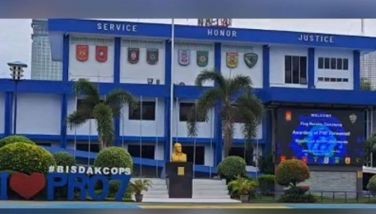Team checks quake damage to churches
CEBU, Philippines - Complying with a request by the Ramon Aboitiz Foundation (RAFI), we formed an ad hoc team with Msgr. Constantino Batoctoy, who runs the Boljoon Studies Center, to check on the damages that some of our precious heritage churches in Southern Cebu had suffered.
Our fact-finding trip brought us to Carcar City and the towns of Sibonga, Argao, Dalaguete, Boljoon. We also checked on Samboan, Cebu.
In Carcar, we were received by Msgr. Rolando Jimenez, parish priest of the city and Vicar General of Cebu. Assistant parish priest Joseph Gabriente showed us around.
On several pillars of church, the decorative ornamentation has cracked, although the structural joints have not been damaged. Minor cracks can also be seen on several arches between the main nave and the aisles.
Carcar, however, can be considered as lucky. According to Msgr. Jimenez, a professional assessment of the safety of the structures confirmed that the church has been structurally unscathed by the forces of the quake.
In Sibonga, we were received by Fr. Junjun Almasol, assistant parish priest, and shown around by the Sacristan Luis Diez.
The church of Sibonga has structurally survived the temblors of the quake quite well. The renowned ceiling painting of the Sibonga church by Raymundo Francia is unharmed. The structure, though, still needs to be assessed, as cracks can now be seen in one of the massive belfries and the pilasters and windows of the church.
Among the churches we have visited so far, the church in Dalaguete has suffered the most. In Dalaguete, we encountered damages that pose an immediate threat to the structural stability of the church.
The roof of its sacristy has caved in and its façade has moved away four inches from the vaulted ceiling. And this is a special concern as the ceiling features paintings done 1935 by Canuto Avila. The conspicuous cracks now run at the center of the façade and along the length of the church’s bell tower. Also well visible is a vertical crack in the front wall along the lookout window.
As immediate measures, Prof. Riichi Miyake of the Fuji Women’s University in Hokkaido, Japan, who is currently in Dalaguete to help in the damage, suggested a support structure that will hold the misaligned front wall in its place. Another immediate measure will be the closure of the gap in the ceiling in order to prevent rainwater from entering and, thus, damaging the precious ceiling paintings.
Also, as relayed by Marivic Calderon, the first lady of Samboan town who accompanied Gov. Hilario Davide III and Vice Gov. Agnes Magpale on an inspection tour of the churches after the earthquake, the Church of Saint Michael Archangel in Samboan was also not spared by the tremors. The belfry has leaned away a few inches from the church building and buttresses and walls show signs of stress.
The governor has already declared that aside from schools, the Cebu Provincial Government is also prioritizing the repairs of Cebu’s churches, which has been declared as heritage sites.
In particular, the churches of Argao, Dalaguete, and Boljoon have been named by the National Historical Commission of the Philippines (NHCP) as National Historical Landmarks. The church of Sibonga has also been given a historical marker by the NHCP.
The National Museum has likewise recognized the Boljoon church as a National Cultural Treasure.
In Boljoon, we had an ocular inspection of the church and a word with the repairs foreman Boy Cairo, who is also a member of the Board of Trustees of the Boljoon Heritage Foundation. Obvious are the stress cracks in the outer cement finish all over the bell tower. It seems, however, that these cracks have no significance to the stability of the bell tower and would be easy to repair.
A major damage to the church caused by the earthquake is on the right side above the lateral door to the shrine. The wall above the door featuring a small round window has entirely detached from the massive pillars and is tilting outwards. Repair works on that damage are already ongoing.
The most serious damage, however, predates the earthquake of 15 October.
The back wall of the church (retablo side) is tilting since quite a while. The detachment measured just before the earthquake has reached a gap of six inches. The earthquake added two inches to the gap of the detachment; it is now eight inches wide.
The good news is that the front façade did not suffer any cracks and is still standing straight. According to Boy, the nave of the church survived the quake fairly well, apart from the damage described above.
Structurally, the Nuestra Señora del Patrocinio church in Boljoon is the oldest of all. The original basic structure of its nave dates back to the early 1700s and so does the watchtower turned belfry.
After all the moro raids, typhoons and earthquakes, the old lady once again essentially stood her ground. (Gerschwiler is an Argao resident and author of the heritage book “Boljoon: A Cultural Sketchâ€. Moreño is curator of RAFI’s Casa Gorordo Museum.) — /RHM (FREEMAN)
- Latest




















